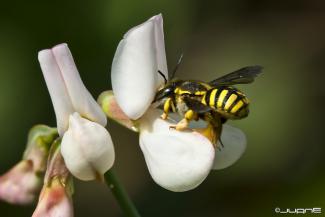
Image Credit: Juan Emilio
Hornet-mimic Bees (Megachilidae: Anthidium, Anthidiellum, Dianthidium, Trachusa)
All of these instantly-recognizable bees are solitary and all females carry pollen under their bellies. Their forms of nesting are extremely diverse. Some species use primarily pre-existing burrows in wood, pith and soil while others build their own burrows and others construct individual cells on rocky ledges covered by glued-together small pieces of sand. Anthidium bees line their burrows and individual cells with plant hairs for insulation; if you have a mullein, lamb’s-quarters or other extremely hairy plant in your garden look for them as they mow paths along the surface exposing the bright-green leaf surface (even if you don’t see them mowing, the mowed paths will remain on the leaf surfaces). I have also seen a species of Anthidium gathering the “cotton” from spent cottonwood and willow seeds.
Nearly all species of solitary male bees are extremely aggressive in defending mating territories near plant species favored by the respective females. Often, these territories are volumes of air within a certain radius around a constantly moving male; other bee species actually defend certain clusters of flowers. But, Anthidium males take territory defense to the extreme; they will challenge any animal species (including people and cattle) if it enters its floral resource territory. Since the defenders are males, and male bees cannot sting, they pose no serious threats to persons but they will (almost) crash themselves into your face.
This group covers quite a diversity of PNW bees. Most of the species are told apart by the shape of the spurs and flanges at the tip of the abdomen. Males and females may have different color patterns (especially on the face) within the same species. Most species are probably potential generalist-feeders, but are usually found on members of the pea family (locoweed (Astragalus), lotus (Acmispon, Lotus) and lupine (Lupinus)) and wild-heliotrope (Phacelia). Most species of Dianthidium are specialists on the sunflower family. The European species, Anthidium manicatum, introduced for greenhouse pollination of commercial tomatoes, has escaped and is now abundant in the later summer in the western valleys of Oregon; it seems to be particularly fond of snapdragons.


Species in the tribe Anthidiini are immediately recognizable anywhere in the world. Though the colorful patterns are eye-catching, be careful because they are quite variable within many of our PNW species.